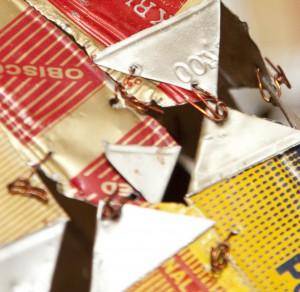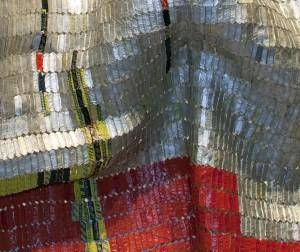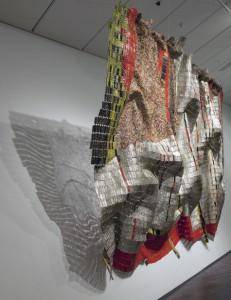Students will collect and transform found materials into a work of art. Through the process they will learn about El Anatsui and his work, as well as explore the difference between two- and three-dimensional art.
Students will be able to:
- discuss the types of materials collected and what they tell about the students’ environment;
- explain how El Anatsui and his assistants made the metal cloth in the Denver Art Museum’s collection;
- articulate the difference between two- and three-dimensional art; and
- work individually and in groups to collaborate on an art project.
Lesson
Pre-lesson Preparation: Have students either bring in (or gather from the cafeteria) different recyclable materials (e.g. pop bottle lids—metal and/or plastic, small cardboard boxes, juice boxes/bags, plastic ties from bread, twist ties, lunch bags, grocery bags, plastic bottles—large and small). Have one cardboard box per type of item to sort the objects. (Tip: For containers that held liquids, you might want to rinse them first in a bleach water solution, set to dry, and then place in a box.)
- Warm-up: Shake the objects within the boxes and have students write at least 3-5 words to describe how each sounds (could share verbally or draw how it sounds). Have students take out three objects and come up with at least five words to describe each, and/or write a poem about each object. The goal is to have them warm up their powers of observation and interaction with the materials.
- Show students different items: bed sheet, paper towel, aluminum foil, butcher paper. Tell them that when flat, these objects are two-dimensional (2D). Ask them to define/describe what that means. Share the definition of three-dimensional (3D) and then in groups of 3 to 4 have them transform the 2D objects to 3D. Did they create something new and different? How did they transform the objects?
- Look at the recycled objects the students collected. Are they 2D, 3D, or both? What would they have to do to make them the opposite (i.e. 2D to 3D and vice versa)?
- Share the picture of El Anatsui’s metal cloth Rain Has No Father? with the students and share information about his process and methods from the About the Art section. Bring in a twist-off metal cap that’s not been changed and one that’s been flattened (can get at a restaurant or liquor store).
- Tell the students that they will be making their own cloth. In groups or individually, students will make sections of the cloth using some of the recycled materials (smaller sections=less time) and then combine their sections into one large piece. (This stage might need to continue the next class period.)
- Allow students time to work in groups of 3 to 4, or individually, to make a small section. You might need to model and let them explore how to manipulate the items and connect them together.
- Give students time to walk around and look at what other groups are doing to inspire their own work.
- Once all of the sections are complete, facilitate the creative, decision-making process of combining them into one tapestry.
- Students can ask administrators to decide on a location to hang and how to hang the piece (much like El Anatsui left the decision to theDenverArt Museum).
- Remind them how El Anatsui’s artwork tells a story. Does their piece tell a story? You can choose to have them write the various stories they come up with about their metal cloth and post those as part of the installation.
Materials
- Cardboard boxes for sorting found/recycled objects
- Found/recycled objects that students gather
- Paper and pencil or pen for each student (may choose to use a sketchbook for this and other activities)
- Assorted materials for students to examine (e.g. brown paper bags, aluminum foil, satin, silk, blankets, cardboard)
- Twist-off metal bottle caps (like those used by El Anatsui)
- Fastening materials—thin gauge wire (such as the kind used to make jewelry), glue/glue sticks, various types of tapes
- If using thin gauge wire, needle nose pliers and wire cutters (at least one for every four students [for younger students, you may want to prepare small lengths of wire ahead of time, or be prepared to do the cutting for them])
- About the Art sheet on Rain Has No Father? (found at the end of the lesson plan) or student access to this part of Creativity Resource online
- About the Art section on Rain Has No Father? (included with the lesson plan)
- One color copy of the metal cloth for every four children, or the ability to project the image onto a wall or screen
Standards
- Visual Arts
- Invent and Discover to Create
- Observe and Learn to Comprehend
- Relate and Connect to Transfer
- Envision and Critique to Reflect
- Language Arts
- Oral Expression and Listening
- Collaboration
- Critical Thinking & Reasoning
- Information Literacy
- Invention
- Self-Direction
Rain Has No Father?
- El Anatsui, Ghanaian, Ewe, b. 1944
- Born: Ghana
- Work Locations: Nsukka, Nigeria
El Anatsui [ah-nat-SOO-ee] was born 1944 in Anyako, Ghana—the youngest, he says, of his father’s 32 children. His mother died when he was quite young, and he was raised by an uncle in a Presbyterian mission. As was common in pre-Independent Ghana, school curriculum, and art school curriculum in particular, were almost entirely Western. Anatsui says this left him feeling restless and rootless and he began looking for ‘‘something that had more relationship to me, as someone growing up in an African country.’’
Anatsui is known for creating art out of found materials such as driftwood, clay, paper, and liquor-bottle tops. He draws on a combination of African aesthetic traditions as well as Western Art history. Plans for this specific work began sometime in 2006, when Curator of Native Arts Nancy Blomberg, along with then Curator of African Art Moyo Okediji, commissioned El Anatsui to create something specifically for the Denver Art Museum. To create his “metal cloths,” Anatsui enlists the help of skilled assistants who work with him in his studio cutting, flattening, and shaping metal liquor bottle tops into design blocks conceived by the artist. Anatsui carefully arranges the different elements on the floor of his studio and, once he is satisfied with the design, his assistants use copper wire to stitch the individual pieces together. Anatsui acknowledges the input of his assistants, noting that the “variety which is needed at this scale comes from the style and the feel of each individual hand.”
Anatsui is currently a Professor of Sculpture at the University of Nigeria, Nsukka, where he has lectured since 1975. His work appears in numerous international and American art museums, including The British Museum in London, Le Centre Pompidou in Paris, and the Metropolitan Museum of Art in New York.
"Art grows out of each particular situation and I believe that artists are better off working with whatever their environment throws up.” - El Anatsui
While out one day, Anatsui came across a bag of liquor bottle tops that were sitting in a bush. He took them back to his studio thinking that he might be able to use them at some point. “I kept the bottle caps in the studio for several months until the idea eventually came to me that by stitching them together I could get them to articulate some statement,” says Anatsui. As the metal pieces were stitched together, he noticed that his artworks began to resemble fabric cloths. “Incidentally too, the colours of the caps seemed to replicate those of traditional kente cloths” (a West African weaving tradition).
While it would be easy to suggest that Anatsui is recycling materials in his artworks, he doesn’t see it that way. Rather, he describes his use of found materials as a “transformation” of those materials. For Anatsui, the inclusion of bottle caps suggests a link between European and African histories: “To me, the bottle tops encapsulate the essence of the alcoholic drinks which were brought to Africa by Europeans as trade items at the time of the earliest contact between the two peoples.”
When creating Rain Has No Father?, El Anatsui was inspired by the grandeur of the Rocky Mountains. The silver cloth is perforated with slashing vertical elements symbolizing “the rain which gives way to life forms.” The three multicolored blocks spread across the top are formed from hundreds of pieces of metal carefully made into tiny open squares—perhaps suggesting clouds holding masses of rain droplets about to be released.
Details

Bottle Caps
Each bottle top, once flattened, is about 4 inches long and 1 inch wide. Gina Laurin, DAM conservator, who worked on repairing the artwork before it was hung, estimates that 9,000 bottle tops were used to make this particular piece. Given the number of artworks Anatsui has created in the last several years, it is currently hard to find used tops. He now goes straight to the distillery to acquire the bottle caps, making newer shinier works.

Copper Wire
Anatsui uses copper wire to hold each piece of aluminum in place. “The process of stitching, especially the repetitive aspect, slows down action and I believe makes thinking deeper,” says Anatsui. “It’s like the effect of a good mantra on the mind.”

Folds
The folds are created in the act of hanging the piece. Anatsui prefers museums to install the metal cloths and create folds. Rain Has no Father? arrived at the museum folded up inside a box. Curator Nancy Blomberg began experimenting with small prototypes—digital images on canvas, 8 ½ x 11 inches—to figure out how the piece would be hung in the gallery. While this was helpful, it was during installation that final decisions on how to best display the work of art were made. The curatorial, installation, and conservation staffs helped to devise a system of pulleys that allowed the DAM to hang the piece safely, as well as manipulate it to create the necessary folds. Installation crews spent a day hanging the work.

Shadow
The surface of this piece is not solid. Light passes through, creating a shadow on the back wall.
Funding for object education resources provided by a grant from the Morgridge Family Foundation. Additional funding provided by the William Randolph Hearst Endowment for Education Programs, and Xcel Energy Foundation. We thank our colleagues at the University of Denver Morgridge College of Education.
The images on this page are intended for classroom use only and may not be reproduced for other reasons without the permission of the Denver Art Museum. This object may not currently be on display at the museum.







